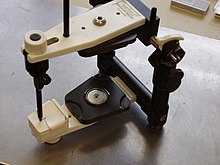This article needs additional citations for verification. (December 2009) |


An articulator is a mechanical hinged device used in dentistry to which plaster casts of the maxillary (upper) and mandibular (lower) jaw are fixed, reproducing some or all the movements of the mandible in relation to the maxilla. The human maxilla is fixed and the scope of movement of the mandible (and therefore the dentition) is dictated by the position and movements of the bilateral temperomandibular joints, which sit in the glenoid fossae in the base of the skull. The temperomandibular joints are not a simple hinge but rotate and translate forward when the mouth is opened.
The principal movements reproduced are: at rest (centric jaw relation), in protrusion (to bite), from side to side (lateral excursion) to chew, in retrusion, and any possible combination of these. Counter-intuitively, it is the cast of the maxilla which moves relative to the cast of the mandible and the articulator.
An articulator assists in the accurate fabrication of the biting surfaces of removable prosthodontic appliances (dentures), fixed prosthodontic restorations (implants, crowns, bridges, inlays and onlays) and orthodontic appliances. Used with skill it ensures correct interdigitation of the teeth and an anatomically functional biting plane. This means less occlusal adjustments before and after fitting dental appliances and fewer chronic conflicts between the teeth and the jaw joints.
Articulators are used mainly by dental technicians in fabrication of prostheses and information regarding bite can be communicated from the prescribing dentist via a facebow alone. However it is advantageous when a system is utilised jointly in which case the clinician should adopt the articulator system currently in use in the dental laboratory as they are not compatible with each other.